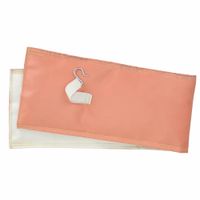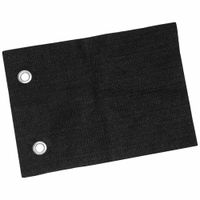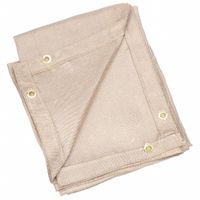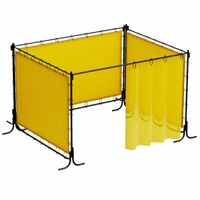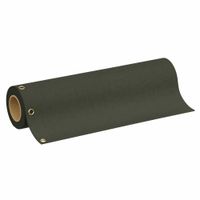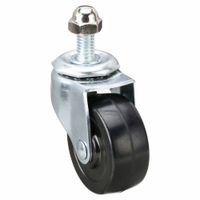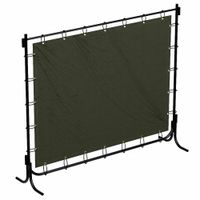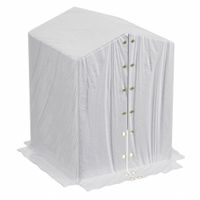Call +(254) 703 030 000 / 751 483 999 / 721 704 777
.....Read More
Frequently Asked Questions
What is the purpose of welding blankets?
Welding blankets are designed to protect equipment, personnel, and the surrounding environment from the hazards associated with welding activities. They serve several key purposes:
1. **Heat Protection**: Welding blankets are made from heat-resistant materials such as fiberglass, silica, or carbon fiber. They provide a barrier against the intense heat generated during welding, preventing damage to nearby surfaces and equipment.
2. **Spark and Spatter Shielding**: During welding, sparks and molten metal spatter can fly off and cause fires or damage. Welding blankets catch and contain these sparks, reducing the risk of fire and protecting sensitive areas.
3. **Fire Prevention**: By acting as a flame-retardant barrier, welding blankets help prevent fires in environments where flammable materials are present. They are essential in maintaining safety standards in workshops and construction sites.
4. **Protection of Personnel**: Welding blankets can be used to shield workers from the harmful effects of UV and infrared radiation emitted during welding. They also protect against burns from accidental contact with hot surfaces.
5. **Equipment and Surface Protection**: They safeguard machinery, tools, and work surfaces from heat and spatter damage, extending the lifespan of equipment and reducing maintenance costs.
6. **Versatility**: Welding blankets are available in various sizes and thicknesses, making them adaptable to different welding tasks and environments. They can be draped over objects, hung as curtains, or laid on floors.
7. **Noise Reduction**: Some welding blankets also provide sound-dampening properties, helping to reduce noise levels in the work area.
Overall, welding blankets are a crucial safety tool in welding operations, ensuring a safer working environment and protecting valuable assets from the adverse effects of welding processes.
How do welding curtains differ from welding screens?
Welding curtains and welding screens are both safety devices used to protect workers and bystanders from the hazards associated with welding, such as sparks, spatter, and harmful UV and infrared radiation. However, they differ in several key aspects:
1. **Material and Construction**:
- **Welding Curtains**: Typically made from flexible, flame-retardant materials like vinyl or PVC, welding curtains are designed to hang vertically. They are often transparent or translucent, allowing some visibility while blocking harmful radiation. The material is usually treated to resist UV degradation and can withstand high temperatures.
- **Welding Screens**: Constructed from more rigid materials, welding screens often consist of a metal frame with a flame-retardant fabric or panel. The fabric can be similar to that used in curtains, but the frame provides additional stability and structure.
2. **Mobility and Flexibility**:
- **Welding Curtains**: These are more flexible and can be easily moved or adjusted. They are often used in environments where the welding area needs to be reconfigured frequently. Curtains can be hung from ceiling tracks or portable frames, allowing for quick setup and removal.
- **Welding Screens**: Generally more stable and less flexible, screens are often mounted on wheels for mobility but are not as easily adjusted as curtains. They are suitable for more permanent or semi-permanent installations where the welding area does not change often.
3. **Applications**:
- **Welding Curtains**: Ideal for creating temporary barriers in large, open spaces or for enclosing irregularly shaped areas. They are often used in workshops where multiple welding operations occur simultaneously.
- **Welding Screens**: Best suited for creating defined, enclosed workstations or for use in smaller, more controlled environments. They provide a more robust barrier against sparks and spatter.
4. **Visibility and Light Transmission**:
- **Welding Curtains**: Allow for some visibility, which can be beneficial for supervision and monitoring of welding activities.
- **Welding Screens**: May offer less visibility depending on the material used, focusing more on creating a solid barrier.
What are the benefits of using welding booths?
Welding booths offer several benefits that enhance safety, efficiency, and quality in welding operations. Firstly, they provide a controlled environment that contains harmful fumes, sparks, and ultraviolet light, protecting both the welder and nearby workers. This containment reduces the risk of respiratory issues and skin burns, ensuring compliance with occupational safety standards.
Secondly, welding booths improve air quality by integrating ventilation systems that extract and filter hazardous fumes and particulates. This not only protects the health of workers but also maintains a cleaner workspace, which can enhance productivity and reduce equipment maintenance costs.
Thirdly, these booths contribute to noise reduction. Welding operations can be loud, and the enclosed space of a booth helps to dampen sound, creating a more comfortable working environment and reducing noise pollution in the facility.
Additionally, welding booths can be customized with specific features such as adjustable lighting, ergonomic workstations, and tool storage, which streamline the welding process and improve precision. This customization can lead to higher quality welds and increased efficiency.
Welding booths also offer flexibility in terms of mobility and scalability. Portable booths can be moved to different locations as needed, and modular designs allow for easy expansion or reconfiguration to accommodate changing production needs.
Finally, by isolating the welding process, booths help prevent cross-contamination of materials and reduce the risk of fire hazards, contributing to overall workplace safety. This isolation also minimizes disruptions to other operations within the facility, allowing for smoother workflow and increased productivity.
In summary, welding booths enhance safety, improve air quality, reduce noise, offer customization, provide flexibility, and ensure high-quality welding outcomes, making them a valuable investment in industrial settings.
How do heat pads protect work surfaces during welding?
Heat pads protect work surfaces during welding by acting as a thermal barrier that absorbs and dissipates heat, preventing damage to the underlying material. They are typically made from heat-resistant materials such as fiberglass, silica, or ceramic fibers, which can withstand high temperatures without degrading.
When welding, intense heat is generated, which can transfer to the work surface and cause warping, burning, or other forms of damage. Heat pads are placed between the welding area and the work surface to mitigate this risk. They insulate the surface by reducing the amount of heat that reaches it, thus maintaining the integrity of the workbench or any other surface being used.
Additionally, heat pads can protect against sparks and molten metal splatter, which are common byproducts of welding. These pads are designed to resist ignition and prevent the spread of fire, adding an extra layer of safety to the welding process.
By using heat pads, welders can ensure that their work surfaces remain undamaged, which is particularly important when working in environments where the surface material is expensive or difficult to replace. This protection also helps maintain a clean and safe workspace, reducing the risk of accidents and prolonging the life of the equipment and surfaces involved in the welding process.
Why are pipeline cooling wraps important in welding?
Pipeline cooling wraps are crucial in welding for several reasons. Firstly, they help manage the heat input during the welding process. Excessive heat can lead to thermal expansion and contraction, causing warping or distortion of the pipeline material. Cooling wraps mitigate this by dissipating heat, maintaining the structural integrity of the pipeline.
Secondly, cooling wraps prevent overheating, which can adversely affect the metallurgical properties of the weld and the surrounding material. Overheating can lead to undesirable microstructural changes, such as grain growth, which can weaken the weld and reduce its toughness. By controlling the temperature, cooling wraps help ensure that the weld and the heat-affected zone retain their desired mechanical properties.
Additionally, cooling wraps reduce the risk of thermal stress and cracking. Rapid temperature changes can induce thermal stress, leading to cracks in the weld or the base material. By providing a controlled cooling rate, these wraps minimize the risk of such defects, enhancing the durability and reliability of the weld.
Moreover, cooling wraps can improve the efficiency of the welding process. By maintaining optimal temperatures, they allow for faster cooling, reducing the overall welding cycle time. This can lead to increased productivity and cost savings, especially in large-scale pipeline projects.
Finally, cooling wraps contribute to safety. By managing heat and preventing overheating, they reduce the risk of burns and other heat-related hazards for welders and other personnel working in close proximity to the welding operation.
In summary, pipeline cooling wraps are essential for maintaining weld quality, preventing defects, enhancing efficiency, and ensuring safety during the welding process.
What are soldering flame barriers used for?
Soldering flame barriers are used to protect surrounding areas and components from the heat and potential damage caused by soldering operations. When soldering, especially in electronics or plumbing, the application of heat is necessary to melt the solder and create a secure joint. However, this heat can inadvertently affect nearby components, materials, or surfaces, potentially causing damage or degradation.
Flame barriers serve several key purposes:
1. **Heat Protection**: They shield sensitive components, wires, or surfaces from the high temperatures generated during soldering. This is crucial in preventing heat damage to components that are not heat-resistant.
2. **Fire Prevention**: By acting as a physical barrier, they reduce the risk of accidental fires, especially when working near flammable materials or in confined spaces.
3. **Safety**: They enhance the safety of the work environment by containing sparks and preventing burns to the operator or damage to the workspace.
4. **Precision**: Flame barriers help maintain the integrity of the soldering process by ensuring that only the intended areas are exposed to heat, which is essential for precision work in electronics.
5. **Efficiency**: By protecting surrounding areas, flame barriers allow for more efficient soldering, as the operator can focus on the task without worrying about collateral damage.
Flame barriers are typically made from heat-resistant materials such as fiberglass, ceramic, or specialized fabrics that can withstand high temperatures. They are available in various forms, including mats, shields, or wraps, to accommodate different soldering tasks and environments.
How do welding tents and umbrellas assist in outdoor welding?
Welding tents and umbrellas are essential tools for outdoor welding, providing several benefits that enhance safety, quality, and efficiency.
Firstly, they offer protection from environmental elements such as wind, rain, and sunlight. Wind can disrupt the shielding gas used in processes like MIG and TIG welding, leading to poor weld quality and increased porosity. Tents and umbrellas create a controlled environment, ensuring the shielding gas remains effective. Rain and moisture can also compromise weld integrity by causing hydrogen-induced cracking. By providing a dry workspace, these shelters prevent moisture-related defects.
Secondly, welding tents and umbrellas shield the welder from direct sunlight, reducing glare and improving visibility. This is crucial for maintaining precision and accuracy in welds. They also protect the welder from UV radiation, which can cause skin burns and eye damage.
Additionally, these structures enhance safety by containing sparks and spatter, reducing the risk of fire hazards in flammable outdoor environments. They also help in noise reduction, which is beneficial in populated areas.
Welding tents and umbrellas are portable and easy to set up, making them convenient for various outdoor locations. They are designed to be durable and resistant to harsh weather conditions, ensuring long-term use.
In summary, welding tents and umbrellas are vital for outdoor welding as they provide protection from environmental factors, enhance weld quality, improve safety, and offer convenience and portability.
What materials are welding blankets typically made from?
Welding blankets are typically made from materials that can withstand high temperatures and provide protection against sparks, spatter, and slag generated during welding processes. Common materials used include:
1. **Fiberglass**: This is one of the most common materials for welding blankets. Fiberglass blankets are heat-resistant and can withstand temperatures up to 1000°F (537°C). They are often treated with a heat-resistant coating to enhance their durability and performance.
2. **Silica Fabric**: High-silica fabrics can endure extremely high temperatures, often up to 1800°F (982°C). These blankets are suitable for heavy-duty welding applications and provide excellent protection against molten metal and extreme heat.
3. **Carbon Fiber**: Known for its high strength and heat resistance, carbon fiber can withstand temperatures up to 1800°F (982°C). It is lightweight and provides excellent protection, making it ideal for high-temperature applications.
4. **Vermiculite-Coated Fiberglass**: This type of blanket is made from fiberglass coated with vermiculite, which enhances its heat resistance and durability. It can typically withstand temperatures up to 1500°F (815°C).
5. **Ceramic Fiber**: Ceramic fiber blankets are used for extremely high-temperature applications, capable of withstanding temperatures up to 2300°F (1260°C). They provide excellent thermal insulation and are often used in industrial settings.
6. **Leather**: While not as heat-resistant as other materials, leather welding blankets are used for lighter welding tasks. They offer good protection against sparks and spatter and are flexible and durable.
These materials are chosen based on the specific requirements of the welding task, including the temperature range, the type of welding, and the level of protection needed.
How do you properly hang welding curtains?
To properly hang welding curtains, follow these steps:
1. **Select the Right Curtains**: Choose welding curtains made from flame-retardant materials like vinyl or fiberglass. Ensure they are the correct size for your workspace and meet safety standards.
2. **Determine the Layout**: Plan the layout based on your workspace. Curtains can be hung in a straight line, U-shape, or around a specific area. Ensure they provide adequate coverage to protect against sparks, UV radiation, and heat.
3. **Install Support Structure**: Use a sturdy frame or track system to support the curtains. This can be a ceiling-mounted track, a freestanding frame, or wall-mounted brackets. Ensure the structure is robust enough to hold the weight of the curtains.
4. **Attach the Curtains**: Use hooks, grommets, or clips to attach the curtains to the support structure. Ensure they are securely fastened and can slide easily if mobility is required.
5. **Ensure Proper Overlap**: If using multiple curtains, ensure they overlap by at least 2-3 inches to prevent gaps that could allow sparks or UV light to escape.
6. **Adjust Height**: Hang the curtains at a height that provides full coverage from the floor to above the welding area. This prevents sparks from escaping underneath or over the top.
7. **Secure the Bottom**: If necessary, secure the bottom of the curtains to prevent them from moving due to drafts or accidental contact. This can be done using weights or ties.
8. **Regular Inspection**: Regularly inspect the curtains for wear and tear, such as holes or burns, and replace them as needed to maintain safety.
9. **Compliance Check**: Ensure the setup complies with local safety regulations and standards for welding environments.
What safety precautions should be taken when using welding screens?
When using welding screens, several safety precautions should be observed to ensure the safety of both the welder and nearby personnel:
1. **Proper Installation**: Ensure welding screens are securely installed and positioned to fully enclose the welding area, preventing exposure to harmful UV and IR radiation.
2. **Material Selection**: Use screens made from flame-retardant materials that can withstand high temperatures and resist sparks and spatter.
3. **Visibility**: Choose screens that provide adequate visibility for monitoring the welding process while still protecting against harmful light emissions.
4. **Size and Coverage**: Ensure screens are large enough to cover the entire welding area, including any potential reflections off nearby surfaces.
5. **Regular Inspection**: Frequently inspect screens for damage such as tears, burns, or discoloration, and replace them as necessary to maintain effectiveness.
6. **Proper Use**: Train personnel on the correct use and positioning of welding screens to maximize protection.
7. **Ventilation**: Ensure adequate ventilation around the welding area to prevent the accumulation of hazardous fumes and gases.
8. **Fire Safety**: Keep flammable materials away from the welding area and have fire extinguishing equipment readily available.
9. **Access Control**: Restrict access to the welding area to authorized personnel only, using screens to delineate the workspace.
10. **Compliance**: Follow all relevant safety standards and regulations, such as those from OSHA or ANSI, regarding the use of welding screens.
11. **Personal Protective Equipment (PPE)**: Ensure welders and nearby workers use appropriate PPE, including welding helmets, gloves, and protective clothing, in conjunction with screens.
12. **Signage**: Post warning signs around the welding area to alert others of the potential hazards.
By adhering to these precautions, the risk of injury or accidents related to welding operations can be significantly reduced.

